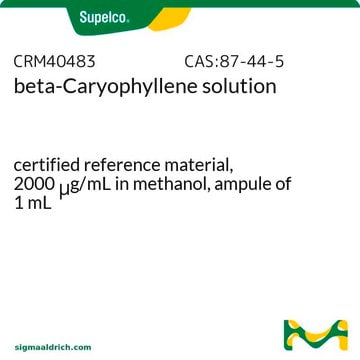74856
(−)-Linalool
analytical standard
Synonym(e):
(R)-(−)-3,7-Dimethyl-1,6-octadien-3-ol
About This Item
Empfohlene Produkte
Qualität
analytical standard
Qualitätsniveau
Assay
≥97.0% (sum of enantiomers, GC)
Optische Aktivität
[α]20/D −20±2°, neat
Haltbarkeit
limited shelf life, expiry date on the label
Methode(n)
HPLC: suitable
gas chromatography (GC): suitable
Brechungsindex
n20/D 1.4615 (lit.)
n20/D 1.462
bp
198 °C (lit.)
Dichte
0.862 g/mL at 20 °C (lit.)
Anwendung(en)
cleaning products
cosmetics
flavors and fragrances
food and beverages
personal care
Format
neat
SMILES String
C\C(C)=C\CC[C@@](C)(O)C=C
InChI
1S/C10H18O/c1-5-10(4,11)8-6-7-9(2)3/h5,7,11H,1,6,8H2,2-4H3/t10-/m0/s1
InChIKey
CDOSHBSSFJOMGT-JTQLQIEISA-N
Suchen Sie nach ähnlichen Produkten? Aufrufen Leitfaden zum Produktvergleich
Allgemeine Beschreibung
Anwendung
- Tea samples using headspace-solid phase microextraction, followed by enantioselective gas chromatography with flame ionization detection (HS-SPME-GC-FID).
- Food matrices using headspace-solid phase microextraction (HS-SPME) coupled to gas chromatography–combustion-isotope ratio mass spectrometry (GC–C-IRMS).
Signalwort
Warning
H-Sätze
Gefahreneinstufungen
Eye Irrit. 2 - Skin Irrit. 2 - Skin Sens. 1 - STOT SE 3
Zielorgane
Respiratory system
Lagerklassenschlüssel
10 - Combustible liquids
WGK
WGK 3
Flammpunkt (°F)
166.3 °F - closed cup
Flammpunkt (°C)
74.6 °C - closed cup
Persönliche Schutzausrüstung
Eyeshields, Gloves, type ABEK (EN14387) respirator filter
Choose from one of the most recent versions:
Besitzen Sie dieses Produkt bereits?
In der Dokumentenbibliothek finden Sie die Dokumentation zu den Produkten, die Sie kürzlich erworben haben.
Kunden haben sich ebenfalls angesehen
Unser Team von Wissenschaftlern verfügt über Erfahrung in allen Forschungsbereichen einschließlich Life Science, Materialwissenschaften, chemischer Synthese, Chromatographie, Analytik und vielen mehr..
Setzen Sie sich mit dem technischen Dienst in Verbindung.











